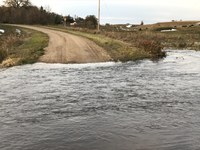Now is the time for ranchers to prepare for flooding
(Click the image below to view a high-resolution image that can be downloaded)
Melting snow is causing challenges for our North Dakota ranchers. North Dakota State University Extension specialists advise ranchers to move available feed to accessible locations and develop plans to assist livestock at risk of flood exposure.
The Red River Basin is at severe risk of flooding along rivers and overland flooding. Ranchers can take steps to ensure that livestock have safe housing and access to feed resources and clean water. Options may include safety in enclosed structures, higher pasture ground, evacuation to higher elevation, or relocation to local alternatives such as an auction barn or fairgrounds.
“Floodwaters can rise quickly, potentially cutting off access to feed and/or water sources for livestock,” warns Miranda Meehan, NDSU Extension livestock environmental stewardship specialist. “Beef cattle out on pasture are especially susceptible to displacement by flooding. Plans should be made ahead of a potential disaster, with consideration given to pens, loading facilities, transportation, evacuation routes and final destination of livestock.”
“Consider the location of barns used for livestock shelter,” says Zac Carlson, NDSU Extension beef specialist. “If a barn is located in a flood plain, like most old barns built close to water, then provide an escape route for the cattle to leave if an overnight flood occurs. Do not shut the barn door unless you check livestock every few hours.”
Floodwaters often prevent ranchers from reaching feed supplies, either directly or through damage to roads. Ranchers should ensure accessible storage facilities and an adequate supply of feedstuffs.
“Ranchers understand at-risk locations, and having a plan for high ground for both feedstuffs and animals is important,” says Travis Hoffman, NDSU Extension and University of Minnesota Extension sheep specialist. “Provide forage as possible, but plan for grain supplementation at or near the barn for calving, lambing or kidding to support energy needs during lactation.”
“Having feed supplies on hand is important because feed assistance may not be available during a flood,” says Karl Hoppe, NDSU Extension livestock systems specialist at the Carrington Research Extension Center. “Ranchers should pre-select sites on high ground for hay, emergency water supplies, and fencing supplies or panels.”
“Please consider that clean water can be a challenge,” says Meehan. “Flood waters may be reservoirs for bacteria, viruses and parasites. Securing clean drinking water shortly after a flood event for rescued livestock assures adequate hydration and improved animal health. Make sure to test livestock water sources that may have become contaminated due to flooding to ensure sources are safe for livestock consumption.”
Wet feeds can be a safety or fire hazard, and moldy feeds can harm animals. While options may be limited, work with your NDSU Extension county agent or a nutritionist on risks and best practices.
“Don’t feed moldy or spoiled feed, as molds in feeds can cause abortions or may be toxic,” says Dr. Gerald Stokka, NDSU Extension veterinarian and livestock stewardship specialist. “Contact your veterinarian, nutritionist, Extension agent or the NDSU Veterinary Diagnostic Laboratory for post-flood analysis of feed safety and quality. Diseases caused by spore-forming bacteria such as Anthrax may be increased from the exposure of overland or river flooding. Consult your veterinarian post-flood if animal health concerns arise.”
Post-flood management should include a physical evaluation of animals for water-related injuries. Flood waters with current can cause stress and muscle weakness, and debris could cause bodily injury.
While not all areas will experience flooding, mud will likely be an issue on many farms and ranches this spring. There are few options once muddy conditions are in place, so preventive practices are key.
These recommendations can aid in reducing muddy conditions:
- Scrape lots to maintain a 3% to 5% slope away from the feed bunk.
- Reshape mounds to ensure quick drainage.
- Move livestock to temporary feeding areas such as stockpiled pastures with adequate drainage or fields containing crop residue such as corn stalks.
“Ranches should evaluate their potential for flooding and plan accordingly,” says Meehan. “If you do not have access to higher ground, you may need to consider moving livestock off-site until the risk of flooding subsides. If you need help evaluating options, contact your NDSU Extension agent or emergency management office.”
Visit NDSU Extension’s flood website at www.ndsu.edu/agriculture/ag-hub/ag-topics/disasters/flood for more information and resources to aid in flood preparations on your operation.
NDSU Agriculture Communication – April 17, 2023
Source: Miranda Meehan, 701-231-7683, miranda.meehan@ndsu.edu
Source: Travis Hoffman, 701-231-2222, travis.hoffman@ndsu.edu
Source: Gerald Stokka, 701-231-5082, gerald.stokka@ndsu.edu
Source: Karl Hoppe, 701-652-2951, karl.hoppe@ndsu.edu
Source: Mary Keena, 701-652-2951, mary.keena@ndsu.edu
Source: Zac Carlson, 701-231-7641, zachary.e.carlson@ndsu.edu
Ed


